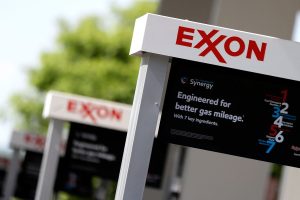Exxon Mobil reported strong a strong third-quarter performance Friday, bolstered by strong Guyana and Permian Basin production.
Exxon earned $7.55 billion, or $1.76 per share, for the period ended Sept. 30. It earned $8.61 billion, or $1.92 per share, in the prior-year period.
Removing one time costs and benefits, earnings were $1.88 per share, which topped the $1.81 per share that Wall Street was looking for, according to a survey by Zacks Investment Research. Exxon does not adjust its reported results based on one-time events such as asset sales.
Revenue totaled $85.29 billion, which was short of the $86.77 billion that analysts had projected.
Third-quarter net production was 4.7 million oil-equivalent barrels per day. That was an increase of 1.1 million oil-equivalent barrels per day when compared with the second quarter.
Guyana production topped 700,000 barrels per day in the quarter. The Permian Basin set a production record of almost 1.7 million oil-equivalent barrels per day.
Also on Friday, Chevron reported third-quarter earnings of $3.54 billion, or $1.82 per share. Earnings, adjusted for pretax expenses, were $1.85 per share.
The results surpassed Wall Street expectations, but Chevron does not adjust its reported results based on one-time events such as asset sales. Analysts surveyed by Zacks Investment Research expected earnings of $1.66 per share.
Chevron’s revenue totaled $49.73 billion, falling short of Wall Street’s estimate of $53.58 billion.
Oil prices spiked last week after the U.S. announced massive new sanctions on Russia’s oil industry in an attempt to get Russian President Vladimir Putin to the negotiating table and end Moscow’s brutal war on Ukraine.
Oil prices have been relatively low for the past few years and in mid-October the cost for a barrel of U.S. benchmark crude fell below $57, its lowest level since early 2021. The price for a barrel of U.S. benchmark crude did rise near $79 a barrel early this year, just before President Donald Trump took office, a price not necessarily considered outrageously elevated by most analysts.
The main reason oil and gas have stabilized at lower levels this year is because of actions by OPEC+. Earlier this month a group of countries that are part of the OPEC+ alliance of oil-exporting countries agreed to a small boost in oil production, citing a steady global economic outlook. The group said after a virtual meeting that it will raise oil production by 137,000 barrels per day in November. The group has been raising output slightly in a series of boosts all year, after announcing cuts in 2023 and 2024.
Russia is the leading non-OPEC member in the 22-country alliance. The group’s next meeting is scheduled for Sunday.
By MICHELLE CHAPMAN
AP Business Writer

